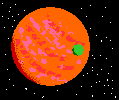

 |
 |
 |
| Sidereal "zero" points of the Yavin-YavinIV system, as chosen for this discussion. |
Note the "zero-degrees" hashes through the diagram of the system. For reference, we will call this "sidereal zero". At this start point, we assume the Massassi Temple is at the sidereal zero on Yavin IV's surface. (If you look very closely you can see the tiny blue mark.)
We know that Yavin IV has a day 24 hours long (1). We assume for simplicity's sake that this is the sidereal day. That is, Yavin IV rotates exactly 360 degrees in 24 hours, and this is measurable relative to the "fixed" stars. As we see later, this is different from its solar day.
We have also determined that Yavin IV orbits the gas giant Yavin once every 12¼ hours.
 |
| After one complete rotation (day), Yavin IV is about 30 minutes' travel shy of completing 2 orbits around the gas giant. |
With each 2-orbit, 1-sidereal-day time block, this 30-minutes'-lag progresses backwards around the orbit until, after 24 SY4Days, Yavin IV is located in a position 15 minutes ahead of the original sidereal-0 position. (To its left in this diagram) Yavin IV's sidereal days and its sidereal orbits work out to an even number after 49 SY4Days. At this time, the Massassi temple is once again at sidereal zero at the same time as Yavin IV is at the sidereal-zero point in its orbit about Yavin. We could refer to this 49-day period as a "Sidereal Yavin Month" (SYM).
Yavin orbits its sun in approximately 13 "standard years" (1). If we assume a standard year of 365 "standard" 24-hour days, this makes a Yavin year 4,745 "standard" (sidereal) days long. I.e. Yavin IV will rotate on its axis 4,745 times in a Yavin year, the same as 4,745 SY4Days.
The even-block of 49 SY4Days does not go evenly into a Yavin year. It goes 96 times, with 41 days left over. After 49 Yavin years (637 "standard years") this works out. On New Year's Day, Yavin IV and Yavin are once again lined up on sidereal-zero at the sidereal-zero point of Yavin's orbit about the sun, for the first time after 637 standard years.
 |
| Shift in the sidereal position of dawn (the dark/light boundary) |
It works out that after 49 days, a given point on Yavin IV sees sunrise 14 minutes and 52 seconds later than it did 49 days ago. A Yavin IV Solar Day (Y4SolDay) is thus 24 hours and 18.2 seconds long.
Note also that as the Yavin system proceeds all the way around the sun in one year, the dark/light boundary has also "shifted" around Yavin and Yavin IV a complete 360°. With the orbital and rotational directions we are assuming, this means that Yavin IV "loses a day." That is, it sees 4744 sunrise-to-sunrise cycles in a sidereal year. Thus the Yavin sidereal year is 4745 sidereal days long, but 4744 solar days long. (By the way, we experience the same case here on Earth.)
We can also determine the period of a solar orbit of Yavin IV (Y4SolOrbit). This is the time it
takes for Yavin IV to line up exactly with the dark/light boundary of Yavin, go around the gas
giant once, and again line up exactly with the dark/light boundary, accounting for the fact that
the system has moved in its orbit around the sun, causing the dark/light boundary to "rotate"
slightly forward around Yavin relative to the sidereal stars. A Yavin IV solar orbit will
thus be slightly more than 360°.
In one hour, Yavin IV moves 360°/12.25 hrs around Yavin.
In one hour, the dark/light boundary moves 360°/113880hrs. (There are 113880 hours in
a Yavin system year, 13 standard years long.) Having determined these two rates of rotary
movement, we solve for the time in which they match up, that is the time of one solar
orbit:
(Yavin IV orbital rate)x(t) = 360° + (dark/light mov't rate)x(t)
or
(360/12.25)x(t) = 360 + (360/113880)x(t)
Solving for t, we find that one Yavin IV Solar orbit is 12.25131787 hours, or 44104.74 seconds, long.
This comes out to about 4.7 seconds longer than a 360°, sidereal orbit.
Due to this extra time for a solar day, a given point on Yavin IV's surface does not
line exactly up again, with the dark/light boundary, (from dawn to dawn) in 49 SY4Days.
In fact, there is no small number of days in which an observer on Yavin IV's
surface will be able to look out at dawn and see themselves lined up with the dawn's edge
on the gas giant, and x number of days later they will see themselves in precisely that
position again. Thus the 49-day "month" has to be a sidereally-observed, not a solar
phenomenon. Logically, the solar days will not line up again until the whole system returns
to its precise sidereal starting point, which as we saw above,
is once every 49 Yavin years, or 637 standard ones.
When he wasn't whiling away his days genetically engineering nasty Sith monsters, Naga Sadow
might have occupied himself with looking at Yavin IV's busy sky. He would have made the
observations we have described above, and would quickly have determined that a sidereal,
not solar calendar, would be the most effective way to go. Much of the Massassi temple
complex could have been designed as a great sidereal observatory, set up to mark the positions
of certain stars at certain points in the Yavin/YavinIV system's movements. Many other
sidereal observations could be made using an accurate clock, and the planet and moon themselves:
All of these observations made together would have served well to enable the Massassi to keep
track of Yavin's and Yavin IV's movements through the skies.
Sacred Numbers:
Sadovian Astronomy and Massassi Sacral Numbers
The system of astronomical observations and calendars developed by the
Sith Lord Naga Sadow, during his exile on Yavin IV.
(2)
4745, the number of sidereal days in a sidereal year, is evenly divisible by the numbers
5, 7, 13, 49, and 73. It is reasonable to assume that these numbers would have taken on a
prominent position in Massassi lore, art, architecture, and superstition over the period
after Naga Sadow's death. The number 49 especially, being also the number of days in a
sidereal month, could be expected to be prominent, as could also the number 7, since 7 times
7 results in 49. Perhaps the Massassi had 7 weeks in a month, of 7 days each.
Credits and Sources (This page only)
1) West End Games' Galaxy Guide 2: Yavin and Bespin © 1995
2) Dark Horse Comics'
The Golden Age of the Sith and The
Fall Of The Sith Empire describe how Naga Sadow and the Massassi got
to Yavin IV.
More on Sidereal Astronomy
Sidereal Time: Cornell's Astronomy 201
Sidereal Vs Solar Time: U of Tennessee Astronomy 161
Length of a (Terran) Sidereal Year-- "Eric's Treasure Troves of Science"
 |
 |  | |
| Back to Crocuta Main | Back To Docking Bay 94 | Back To Yavin IV |